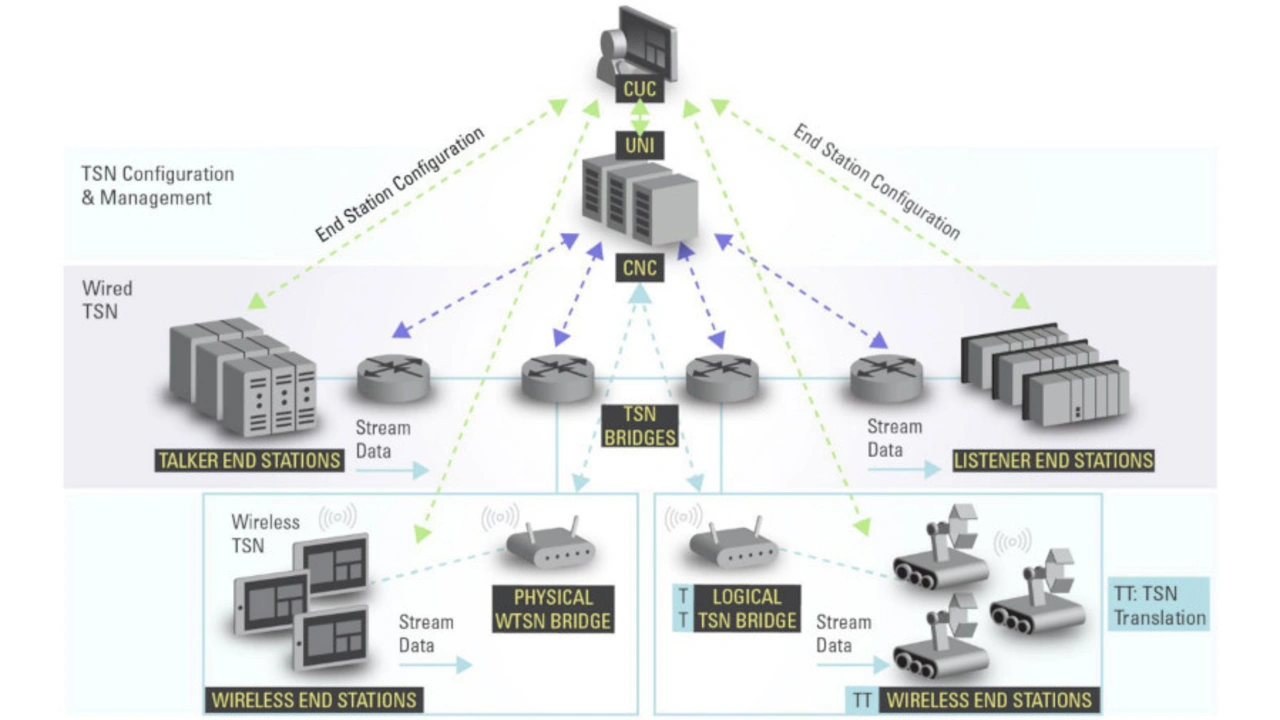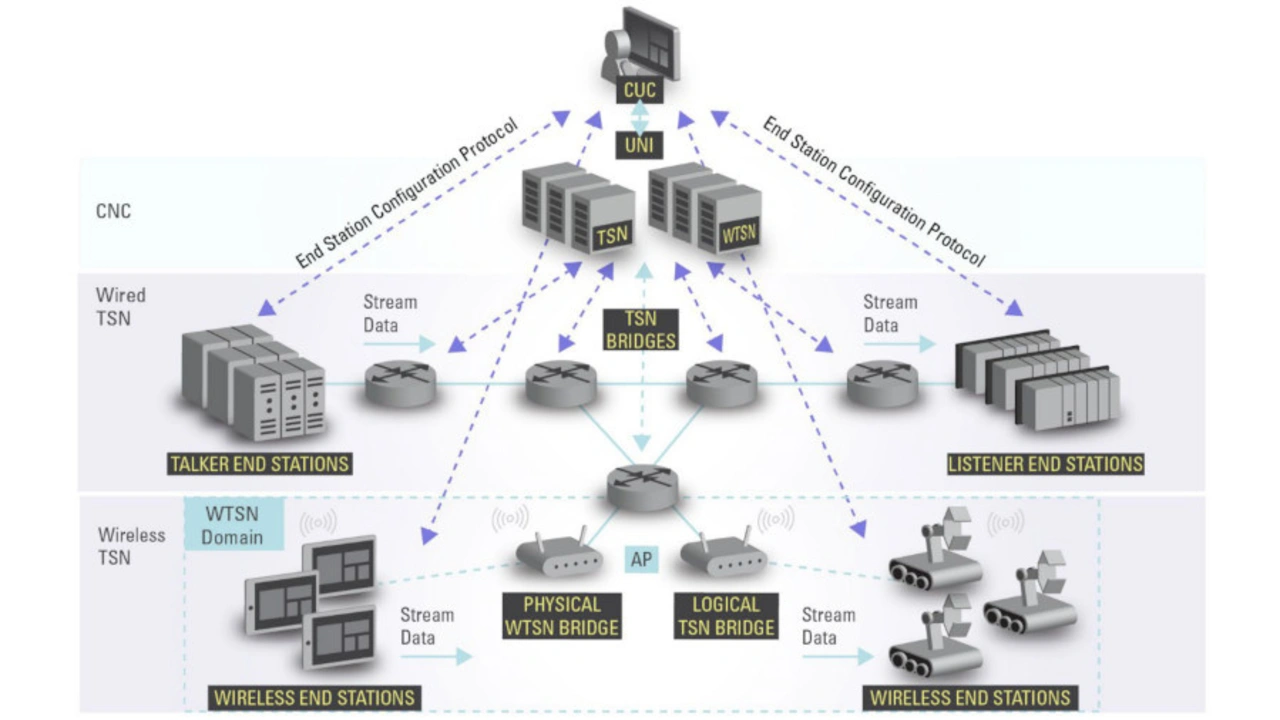Time-Sensitive Networking
Market Expectations, Capabilities & Certification
Fortsetzung des Artikels von Teil 2
Network Management Considerations
When both wired and wireless devices implement the same TSN reference protocol stack, it is possible to manage a wireless TSN segment as a physical TSN bridge. For instance, when both 802.3 (Ethernet) and 802.11 (Wi-Fi) implement TSN features, a seamless integration of wired and wireless TSN is possible as shown in Figure 3. TSN-capable Access Points operate as wireless TSN bridges between wired and wireless segments, and the 802.11 Stations (STAs/Wi-Fi clients) operate as TSN end stations.

The wireless system may also be implemented as a »virtual« TSN bridge. In this model, the wireless network may not implement all the TSN specifications, but it still enables the expected TSN performance across the wireless system. For instance, the 3GPP Rel. 16 specification defined new interfaces to integrate a 5G system (5GS) with a TSN-capable network as a »virtual« or logical TSN
bridge(s) providing a control plane interface and TSN ports at the user plane. As shown in Figure 3, this bridge model is enabled by TSN Translators (TT), one at the UE side called Device-Side TT (DS-TT) and the other at the network-side called Network- Side TT (NS-TT), which are 3GPP defined gateways responsible for tunneling the traffic streams from the TSN segments across the 5GS. The main assumption in this model is that the 5GS will use its own capabilities (e.g., 5G clock synchronization, URLLC, scheduling) to deliver the expected TSN performance in terms of time synchronization (802.1AS) and data delivery under a worst-case latency (802.1Qbv) when the data stream is transferred across the 5G network. A 5G control plane has also been defined to interface with the TSN management entities via TSN Application Functions called TSN-AF.
The hybrid model in Figure 4 extends the TSN configuration by allowing the identification and management of wireless links. In this model, the TSN configuration can be »wireless-aware,« and wireless-specific characteristics can be considered inthe overall network configuration and management.

Like in the physical model, in the hybrid model both wired and wireless devices implement TSN features. It also allows the network configuration to abstract certain wireless-specific characteristics as in the virtual model. The hybrid model may be enabled by a WTSN block within the CNC, as shown in Figure 4, which implements the »wireless-aware« capability to manage wireless links. In an actual implementation, the TSN and WTSN configuration blocks will need to coordinate the overall end-to-end configuration.
One important benefit of this model is to minimize changes in the wired part of the network by being wireless-aware. For instance, when scheduling protected windows (part of 802.1Qbv) as a time- critical stream starting in the wired network and ending with a wireless link, the CNC can define a schedule that completes wired transmissions as fast as possible and leaves more time for the wireless links to account for potential variations on the achievable link speeds without requiring re- computing the overall network schedule.
The most suitible management model will depend on the specific wireless connectivity and deployment scenario. Wi-Fi can be used in all three models depending on the cpabilities implemented in the Wi- Fi devices. On the other hand, 5G can only be used in a virtual/logical bridge model. It is important to be able to verify and measure TSN-relevant KPIs independent of the management model used.
The TSN configuration models (in Figure 3 and 4) are application-agnostic and focus only on the TSN features. Additional application-specific aspects may need to be considered depending on the market segment. For instance, in ProAV, hybrid wired- wireless deployments will require bridging between AVB standards and protocols and WTSN features. In industrial deployments, application-level protocols may also need to be considered for end-to-end interoperability.
Interoperability Testing and Certification
Testing WTSN devices and systems is an important step towards deployment in the field. Avnu has a unified approach to testing for the certification of TSN capabilities in wired and wireless networks. Avnu develops test specifications, testing tools, and enables interoperability testing events where vendors can verify functionality and prepare their products for TSN certification.
Avnu’s test specifications focus on the TSN features. Basic wireless connectivity functionalities are outside of the scope. Other industry organizations, such as Wi-Fi Alliance and 3GPP test houses are responsible for verifying the underlaying connectivity capabilities. The WTSN tests include media-independent features that are common across wired and wireless, but it may also include media- dependent features if they are required to support a given TSN capability.
Test specifications for core TSN features, such as 802.1AS and 802.1Qbv/Qav, initially done for wired (Ethernet) devices, are also being extended to wireless devices and systems.
Conclusion
Wireless use cases have a wide range of requirements, but core TSN features (time synchronization, traffic scheduling, and reliability enhancements) are needed over wireless to support most use cases. Wireless-specific aspects also need to be considered in deployment, configuration, and management of wired and wireless TSN devices and systems. A unified wired-wireless TSN architecture is key to scale adoption of the technology.
The Avnu Alliance is leading the development of wired and wireless TSN testing to validate conformance to standards and ensure interoperability. In addition to the development of test specification and tools, the WTSN working group is preparing to host testing events where industry partners can collaborate to verify functionality and performance of WTSN products.
References
[1] Avnu Alliance, https://avnu.org.
[2] IEC/IEEE 60802 TSN Profile for Industrial Automation. IEEE, https://1.ieee802.org/tsn/iec-ieee-60802.
The author

Dave Cavalcanti
received his PhD in computer science and engineering in 2006 from the University of Cincinnati. He is currently Principal Engineer at Intel Corporation where he develops next generation wireless connectivity and networking technologies and their applications in autonomous, time-sensitive systems.
He leads a team developing Wireless Time-Sensitive Networking capabilities over next generation 802.11 and 5G networks. He is Senior Member of the IEEE and serves as the chair of the Wireless TSN working group in the Avnu Alliance.
- Market Expectations, Capabilities & Certification
- Wireless TSN Capabilities
- Network Management Considerations





